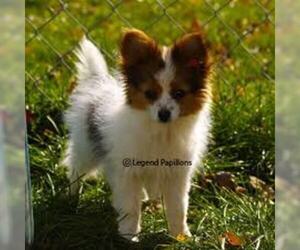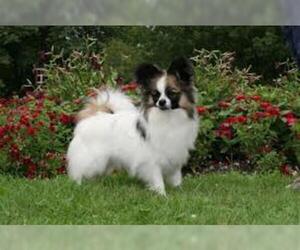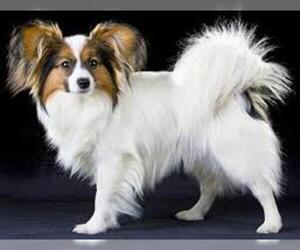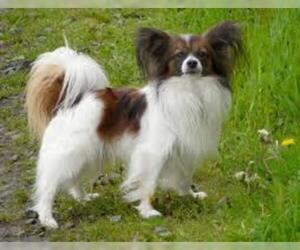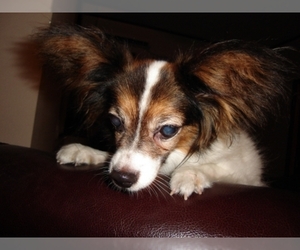
All about Papillon dog breed
A.K.A. :Butterfly Dog, Dwarf Spaniel, Continental Toy Spaniel, Phalene, Épagneul Nain Continental, Small Continental Spaniel, Squirrel Dog, Papillons, Papillon Dog, Papillons Dog, Phalène, Phalène Dog, Pap, Paps, Butterfly, Épagneul nain
Size
Grooming requirements
Exercise requirements
Good with other dogs
Watchdog ability
Energetic
Training requirements
Playful
Affectionate
Good with other pets
Good with children
Good with strangers
Winter
Summer
Healthiness
Protective
Life Span
| Pure Breeds | Member |
| Breeds A - Z | P |
| Breeds by Group | Companion Toy |
| Breeds by Trait | Good With Kids Low Shedding Smartest Dog Breeds |
| Overview: | The enchanting Papillon, whose name translates to "butterfly" in French, truly lives up to its moniker with its distinctive, fringed ears that resemble delicate wings. Originating from European royalty and depicted in art as early as the 16th century, these elegant toy dogs were once known as Continental Toy Spaniels. Physically, they are small but sturdy, typically weighing between 5 to 10 pounds, with a long, silky coat that requires regular brushing to prevent tangles. Their temperament is a delightful blend of intelligence, playfulness, and affection, making them highly trainable and eager to please. Papillons are surprisingly energetic for their size, enjoying walks and mental stimulation, yet they are equally content to cuddle on a lap. They are generally well-suited for apartment living due to their compact size, and their friendly nature often makes them good companions for families with older, respectful children. While generally healthy, responsible breeders screen for potential issues such as patellar luxation and progressive retinal atrophy. Overall, the Papillon is a charming, adaptable companion that brings joy and elegance to any home. |
F.A.Q.
All You Need to Know About the Papillon Breed
The Papillon, meaning "butterfly" in French, is a delightful toy breed renowned for its distinctive butterfly-like ears and elegant plume tail. Originating from European nobility, these intelligent and affectionate dogs are surprisingly robust and adaptable. Their temperament is generally cheerful, friendly, and outgoing, making them excellent companions for singles, seniors, and families with older, respectful children. Papillons thrive in apartment living due to their small size and moderate exercise needs, typically satisfied with daily walks and indoor play. While their fine, silky coat requires minimal grooming—a weekly brush keeps it tangle-free—they are low-shedding. Common health considerations include patellar luxation and dental issues, emphasizing the importance of responsible breeding and regular vet check-ups. Overall, the Papillon is a charming, adaptable, and relatively low-maintenance companion perfect for various lifestyles.What is the average healthy weight for a Papillon?The average healthy weight for a Papillon is typically between 5 to 10 pounds. Adult Papillon weight can vary slightly, with most falling within this range. While there isn't a significant size difference between males and females, males might occasionally be at the higher end of the spectrum. Maintaining a healthy weight for Papillon is crucial for their well-being.
What is the average height of a Papillon in inches?When considering a Papillon for adoption, you might be wondering, "how tall is a Papillon?" These delightful dogs are known for their dainty yet elegant stature. The average height of a Papillon typically ranges from 8 to 11 inches tall at the shoulder. This measurement is taken from the ground to the top of their shoulder blades, which is the standard way to determine a dog's height.While both male and female Papillons generally fall within this range, you might observe slight variations. Some male Papillons may lean towards the higher end of the spectrum, while females might be a bit smaller. However, these differences are usually minimal and often come down to individual genetics within a litter. Breeders strive for consistency, but just like people, there can be slight variations in size from one dog to another.So, for those curious about Papillon height and their average size, expect a small, compact companion that easily fits into most lifestyles and living spaces!
The Papillon colors come in a beautiful array, with most being parti-color (white with patches of another color). AKC recognized Papillon colors include any color or combination of colors, provided the nose, eye rims, and lips are pigmented black. Common and accepted variations include sable, red, lemon, tricolor (black and tan with white), fawn, and cream. White must always be present on the underbody, feet, and partially on the legs, with a blaze on the face. Solid color Papillons are not accepted.Beyond the standard, rare coat types and exotic Papillon variations exist, though many are not recognized by major kennel clubs like the AKC. These can include brindle, blue (a dilute black), lilac (a dilute chocolate), chocolate (brown pigmentation instead of black), and even merle. While visually striking, these rare Papillon colors often indicate different genetic backgrounds and may not be desirable for conformation showing under AKC rules. Potential adopters or buyers should be aware that rare Papillon colors like blue or merle might carry associated health risks and typically come from breeders focusing on unique aesthetics rather than breed standard. Prices for Papillons with these unusual colorings can vary significantly.
The Papillon personality is characterized by an intelligent, lively, and affectionate nature. These charming dogs are known for their friendly temperament, displaying strong loyalty to their families. They are highly sociable, enjoying the company of their human companions and often thriving in social settings. Papillons are remarkably adaptable to apartment living due to their smaller size and moderate exercise needs, though they do appreciate outdoor play. When it comes to behavior with children, they can be excellent companions for older, respectful children who understand how to interact gently with a small dog. With proper socialization, they generally get along well with other pets, including cats, and can co-exist peacefully, often displaying their playful side. Their bright and eager-to-please nature makes them relatively easy to train, further adding to their appeal as a delightful companion.
The Papillon temperament is generally described as delightful and affectionate, making them excellent companion dogs. They are known for their lively and outgoing personalities, often displaying a confident and graceful demeanor. Papillons are highly intelligent and eager to please, though they can sometimes show a touch of stubbornness, which is usually manageable with consistent, positive reinforcement training. They are very friendly and sociable, thriving on human interaction and forming strong, loyal bonds with their families. Their adaptability makes them well-suited for apartment living, provided they receive adequate mental and physical stimulation. With children, Papillons are typically good-natured and playful, but due to their delicate size, supervision is always recommended, especially with very young children, to ensure gentle interactions. They generally get along well with other pets, particularly if socialized from a young age. While generally robust in personality, they can be somewhat sensitive to harsh treatment or prolonged periods of neglect, flourishing best in a loving and attentive environment. Their personality traits include alertness and a surprising amount of courage for their size.
Papillon Care: Daily Maintenance & Health TipsPapillon care involves relatively straightforward yet consistent attention. Grooming needs for their single, silky coat are minimal; brush a few times a week to prevent tangles and reduce shedding. Bathe as needed, typically every 3-4 weeks. Due to their delicate ears, check them regularly for cleanliness and signs of infection.Despite being a low-energy dog breed, Papillons still require daily exercise. Short, brisk walks or active playtime indoors are usually sufficient to meet their needs and prevent boredom. This contributes to good weight management, a crucial aspect given their small size.Dietary considerations should focus on high-quality small-breed dog food appropriate for their life stage. Avoid overfeeding to prevent obesity, which can exacerbate other health issues.Papillons are not a brachycephalic breed and do not have wrinkles requiring special cleaning. However, their long, delicate ears do necessitate regular inspection and gentle cleaning to prevent wax buildup and infections. Their single coat offers some insulation, but they are climate sensitive to extreme cold and heat. Provide appropriate shelter and limit exposure during harsh weather.Common health tips for Papillon include vigilant dental care; daily brushing or dental chews are recommended to prevent periodontal disease, a prevalent issue in small breeds. Monitor for skin issues such as allergies or dry skin, often indicated by scratching or redness. Regular veterinary check-ups are essential for early detection and treatment of potential health concerns.
Papillon Activity Level: Energetic and Playful, Yet Adaptable
The Papillon activity level is generally moderate to high, making them a surprisingly energetic and playful companion despite their small size. While they enjoy short bursts of intense activity, they are also content with significant periods of rest and relaxation. Understanding their exercise needs is key to a happy Papillon.Typically, Papillons possess a lively and curious nature. They thrive on mental stimulation and benefit from daily walks, interactive playtime, and opportunities to explore safely. Expect your Papillon to enjoy a good game of fetch, chasing toys, or learning new tricks. Their intelligence means they excel in activities like agility, though these should be adapted to their small stature and general health.Regarding how active are Papillon, they require at least 30-60 minutes of dedicated exercise daily, which can be broken into multiple sessions. This could include two short walks, a longer playtime session in the yard, or indoor games that engage their minds and bodies. They are not dogs that can be left unstimulated for long periods; boredom can lead to undesirable behaviors.It's important to note the limitations due to their brachycephalic (short-nosed) anatomy. While Papillons are not as severely brachycephalic as some other breeds, they can still be susceptible to overheating and respiratory difficulties, especially in hot or humid weather, or during strenuous exercise. Always monitor their breathing and avoid over-exertion. Always provide fresh water and a cool resting place.Papillons excel at balancing their energy. They can be incredibly active and engage enthusiastically in playtime, but they are equally adept at curling up on the couch for a long nap. This makes them surprisingly versatile. They are suitable for active families who enjoy daily walks and interactive play, but their adaptability also makes them a good fit for low-energy households that can commit to consistent, albeit moderate, daily activity. They are not content to be purely decorative; they need engagement and a purpose.Breed Breakdown: What Experts Say About the Papillon
I would rate the "Size" trait of the Papillon breed as a 2.This rating reflects the Papillon's extremely small stature. With an average height of only 8-11 inches and a weight of 5-10 pounds, they are among the smallest dog breeds. Their delicate bone structure and compact body further emphasize their miniature size. Compared to other companion dogs, even those considered small (like many terriers or miniature poodles), Papillons are noticeably daintier. This makes them exceptionally well-suited for apartment living, as they require very little physical space. Their small size also makes them excellent travel companions, easily fitting into pet carriers for car, train, or even plane journeys. For households with space constraints, the Papillon is an ideal choice, as they don't demand much room to roam.
I would rate the grooming requirements of the Papillon at a 6 out of 10.While the Papillon's single coat is beautiful, it's not as low-maintenance as some might assume, placing it squarely in the moderate-to-high category. Their long, silken fur, particularly around the ears, chest, and tail, is prone to tangles and mats if not brushed regularly – at least every other day, and ideally daily. This isn't just for aesthetics; mats can pull on the skin and cause discomfort or even skin infections. They are moderate shedder, meaning you'll find some hair around the house, but it's generally manageable with consistent brushing. Ear cleaning is important due to their large, fringed ears, which can trap dirt or moisture, and their nails grow quickly and need frequent trimming to prevent overgrowth. Regular bathing, perhaps every 3-4 weeks, is needed to keep their coat clean and healthy. While not particularly prone to skin folds or severe allergies compared to some other breeds, their long coat does require attentive care to keep it free from debris and potential irritants. Therefore, while not demanding daily professional grooming, they definitely require consistent at-home care and attention to maintain their coat and overall hygiene.
I'd rate the Papillon's "Exercise Requirements" a 6 out of 10.While they are small, the Papillon is not a couch potato and possesses surprising energy and athleticism for its size. They thrive on daily activity, usually benefiting from at least 30-60 minutes of varied exercise. This can include brisk walks, enthusiastic playtime in a secure yard, or engaging in canine sports like agility or obedience, where they often excel due to their intelligence and eagerness to please. Their small stature and non-brachycephalic (not flat-faced) anatomy mean they generally have good stamina and no significant respiratory limitations, allowing them to tolerate sustained movement better than some toy breeds. They are mentally stimulated by having a purpose and enjoy learning tricks or participating in structured activities. While they can adapt to a more relaxed day, a lack of sufficient exercise can lead to boredom and potential behavioral issues. They don't require the intense, long-distance runs of a working breed, but they are certainly not satisfied with just a short potty break and prefer a more active lifestyle to stay healthy and mentally stimulated.
I'd rate the Papillon's "Watchdog Ability" at a 7 out of 10.While not a breed known for its physical deterrence, the Papillon excels in providing highly effective early warnings. They are incredibly alert and possess keen hearing, often noticing the slightest unusual sound or movement long before their human companions. This leads to frequent, sharp bursts of barking directed at anything perceived as out of the ordinary – a passing mail carrier, a squirrel on the fence, or a knock at the door. Their territorial instincts, though not aggressive, are strong enough to prompt vocalization when their space or people are approached by unfamiliar individuals. They aren't typically inclined to physically confront an intruder, but their persistent, high-pitched barking is undeniably attention-grabbing and would certainly alert residents to a potential problem, making them excellent "doorbells" and providing meaningful early warnings in a home environment. They are far from a passive companion in this regard; their small size belies a surprisingly vocal and vigilant nature.
I would rate the "Good with Other Dogs" trait of the Papillon breed as an 8.Papillons are generally very sociable and dog-friendly, especially with proper early socialization. They typically enjoy the company of other dogs and are often seen happily interacting in playgroups. Their adaptable nature means they can usually get along with dogs of various sizes and energy levels, though they might prefer other smaller, gentler playmates. While they can hold their own, they are rarely aggressive or dominant. They thrive in canine company and often enjoy being part of a multi-dog household, often forming strong bonds with their canine companions. However, like any breed, individual personalities vary, and careful introductions are always recommended, especially with much larger or more boisterous dogs who might accidentally injure a smaller Papillon. While they generally coexist peacefully, continued positive reinforcement and socialization help ensure they remain well-adjusted and friendly throughout their lives.
I would rate the "Energetic" trait of the Papillon breed as an 8 out of 10.Papillons are surprisingly energetic for a small toy breed. They possess a high typical activity level, always seemingly ready for a game or an exploration. Their endurance is quite good for their size, allowing them to participate in extended play sessions or walks. Playfulness is a hallmark of the breed, and they actively seek out interaction and amusement. They have a significant need for physical stimulation; a bored Papillon can become a mischievous one. Their agility and quickness make them excellent candidates for dog sports like agility, flyball, and obedience, and they can certainly participate in outdoor or athletic activities, often surprising owners with their stamina on hikes or long walks. Compared to many other companion dogs, they are naturally active and far from laid-back. However, their brachycephalic (though not extremely so) anatomy, while not as pronounced as breeds like Pugs or Bulldogs, can still slightly affect their stamina and exercise tolerance in extreme heat or during very strenuous, prolonged activity. While they are energetic and enjoy exercise, owners should be mindful of overheating and provide breaks, especially in warmer climates, due to their shortened muzzle. They are not built for truly extreme, continuous exertion like a Border Collie, but for a toy breed, their energy levels are remarkably high and require regular outlets.
I'd rate the Papillon's "Training Requirements" at a 3.Papillons are generally very intelligent and eager to please, making them relatively easy to train. They possess a good attention span for their size and respond very well to positive reinforcement methods, thriving on praise, treats, and interactive games. While they can have a mischievous streak and an independent thought process common in intelligent breeds, they are not typically stubborn or difficult to motivate. Their responsiveness to commands is high, and they pick up new tricks and routines quickly. Consistency is always beneficial in any training, but with a Papillon, it often solidifies good habits rather than constantly battling resistance. This breed is quite beginner-friendly, and while structured routines help, they don't necessarily require experienced handling to become well-behaved companions. Their biggest training challenge often lies in managing their high energy and ensuring their mental stimulation is met to prevent boredom-induced behaviors rather than a lack of trainability.
I'd rate the Papillon's "Playful" trait a solid 9 out of 10. Papillons are renowned for their effervescent personalities, making them naturally spirited companion dogs. They possess a remarkably high activity level for a small breed, always ready for a romp or a game, and their love for interaction is almost boundless. These charming dogs are frequent attention-seekers, often initiating playtime by bringing toys or nudging their owners for engagement. They respond to toys and playtime with an incredible enthusiasm, often displaying impressive agility and quick thinking during games like fetch or hide-and-seek. Their overall enthusiasm in daily life is infectious; they approach most situations with a cheerful and inquisitive demeanor, rarely being described as laid-back when compared to other companion breeds.
I would rate the "Affectionate" trait of the Papillon breed at a strong 9 out of 10.Papillons are renowned for their intensely loving and people-oriented nature. They have a profound desire for human companionship and truly thrive on affection, often forming very strong bonds with their owners. Physical closeness is a hallmark of their affection; they are quintessential lap dogs, delighting in cuddling and always keen to be near their human family members. This manifests as a strong tendency to follow their owners from room to room, acting as little shadows. Their loyalty is unwavering, and they are remarkably sensitive to owner emotions, often picking up on moods and responding with comforting nudges or playful attempts to cheer you up. Compared to many other companion dogs, they are far from independent; instead, they deeply crave interaction and inclusion in family activities, making them incredibly devoted and affectionate companions.
I would rate the "Good with Other Pets" trait of the Papillon breed at a solid 8 out of 10.Papillons are generally quite amiable and adaptable little dogs, making them good candidates for multi-pet households. Their typical behavior around other dogs is usually positive; they tend to be playful and curious rather than aggressive or dominant. While they possess a moderate prey drive common to many small breeds (especially towards very small, fast-moving critters), this is generally manageable and less intense than in dedicated hunting breeds. Resource guarding tendencies are typically low to moderate and can often be mitigated with proper training and early socialization. Papillons are naturally sociable and enjoy company, often extending this friendliness to other well-behaved pets. While early socialization is always beneficial for any dog to ensure they develop good manners, Papillons often *naturally* lean towards peaceful coexistence, making them relatively easy to integrate. They adapt well to new situations and are often happy to share their space and attention, provided they receive adequate individual attention as well. With reasonable introductions and supervision, they can coexist peacefully with both other dogs and cats, sometimes even forming surprisingly close bonds.
The Papillon breed rates a 7 out of 10 for "Good with Children."Papillons are generally affectionate and can be quite playful, which makes them appealing to children. They are often described as intelligent and eager to please, meaning they can respond well to training and positive reinforcement. Their small size can be a benefit, as they are less likely to accidentally knock over a young child. However, this small stature also makes them somewhat delicate, and they can be easily injured by rough handling. While they can be patient, their tolerance for constant noise and rambunctious play has limits, and they may become overwhelmed or snappy if not given space or if handled too roughly. They are naturally gentle with older, more considerate children who understand how to interact with a small dog, but require significant supervision and training for both the dog and younger children to ensure a harmonious environment. They are not as inherently bomb-proof as some larger, more stoic breeds, and therefore, their success in a family with children largely depends on responsible parenting and proper introduction and training from a young age.
I would rate the "Good with Strangers" trait of the Papillon breed at an 8.Papillons are generally known for being quite friendly and outgoing, even with unfamiliar adults. They are not typically reserved or shy, and their natural curiosity often leads them to approach new people with an wagging tail and an eagerness for attention. While they are loyal to their families, they tend to extend their cheerful disposition to guests and people encountered in public. They aren't usually prone to excessive barking or guarding behavior towards strangers; their small size and affectionate nature lend themselves more to greeting than to guarding. They are highly adaptable in various environments, including those with many people, and often thrive on the social interaction. While good socialization as a puppy will always enhance a dog's confidence, Papillons are naturally predisposed to being comfortable and welcoming towards strangers rather than requiring extensive training to overcome shyness.
I would rate the Papillon's "Winter" tolerance at a 3. They are quite sensitive to cold due to their small size, very thin single coat which offers minimal insulation, and low body fat. While not brachycephalic, their delicate frame makes them susceptible to rapid heat loss. The risk of hypothermia is significant, especially in prolonged exposure or very low temperatures. They can enjoy very brief outings in moderate cold, but require special care during winter months compared to many other companion dogs. This includes sweaters or coats for walks, limited outdoor time, and a warm indoor environment, as they struggle to maintain core body temperature and are not equipped for extended outdoor activity in cold climates.
I'd rate the Papillon's "Summer" tolerance at a 4.While not brachycephalic, Papillons are small, active dogs with a single coat, meaning they can overheat relatively quickly. Their delicate structure makes them more susceptible to the adverse effects of heatstroke compared to larger, more robust breeds. They have a good ability to regulate body temperature through panting, but this mechanism can be overwhelmed in high heat and humidity. Outdoor activity should be significantly limited during the hottest parts of the day, typically mornings and evenings are best, and always in shaded areas. They are highly prone to heatstroke if left unsupervised or overexerted in the sun. Therefore, Papillons absolutely require special care in summer months compared to many other companion dogs. They benefit greatly from air conditioning, plenty of fresh water, and a cool environment to retreat to. Extended periods outdoors without shade or access to cooling is not recommended.
I would rate the Papillon breed's "Healthiness" trait as an 8 out of 10.Papillons are generally considered a very healthy and robust breed, especially for a toy dog. They boast a relatively long life expectancy, often reaching 14-16 years, and are not typically prone to the severe breathing difficulties or widespread joint problems seen in some other small breeds. While they do have some genetic predispositions, such as patellar luxation (slipping kneecaps), progressive retinal atrophy (an eye condition), and occasional dental issues, these are often manageable with responsible breeding practices and early veterinary intervention. Hypoglycemia can be a concern in very young puppies. Compared to many other companion dogs, they are not particularly high-maintenance in terms of health, often requiring standard preventive care and regular dental hygiene. Their active nature and lean build also contribute to good overall fitness.
I would rate the "Protective" trait of the Papillon breed as a 3 out of 10.While Papillons are highly alert and possess excellent hearing, making them fantastic "alarm bells" that will readily bark at the approach of strangers or unusual sounds, their protective instincts largely end there. They are deeply loyal to their owners, but their small size and generally gentle, friendly nature mean they lack any significant territorial aggression or the physical capability to offer meaningful protection beyond alerting. They are more likely to greet a stranger with curiosity (after an initial bark) than to act aggressively. They are almost exclusively companion dogs, excelling at providing affection and entertainment, rather than offering any physical deterrence or guard dog capabilities in a household setting.
I would rate the "Life Span" trait of the Papillon breed an 8.Papillons are widely considered a long-lived breed among companion dogs. Their average life expectancy typically ranges from 13 to 15 years, with many individuals living even longer, often reaching 16 or 17 years and beyond. This places them significantly above the average lifespan for many dog breeds. While they do have some genetic predispositions to conditions like patellar luxation, progressive retinal atrophy, and dental issues, these are often manageable or, in the case of PRA, can be screened for by responsible breeders. Compared to larger breeds that often have shorter lifespans due to size-related health complications, Papillons generally benefit from their small stature and a relatively robust genetic profile when bred responsibly. Good care, including proper nutrition, regular exercise, and veterinary check-ups, further contributes to their impressive longevity.
Papillon Puppies for saleSee all puppies for sale
Papillon Dogs for adoptionSee all dogs for adoption
Papillon BreedersSee all breeders
Similar Dog Breeds for Papillon
Breed Mixes of Papillon
Quick Breed Selector 0 - not important, 1 - smallest, 10 - largest
Variants & Mistakes :Papilion, Papillion, Papilon, Papiyon, Papillian, Pappilon, Papalion, Papyion, Papiion, Papillo, Papallon, Papallion, Papiellon, Pappillon, Papillons, Papellon, Papiilon, Papiillon
